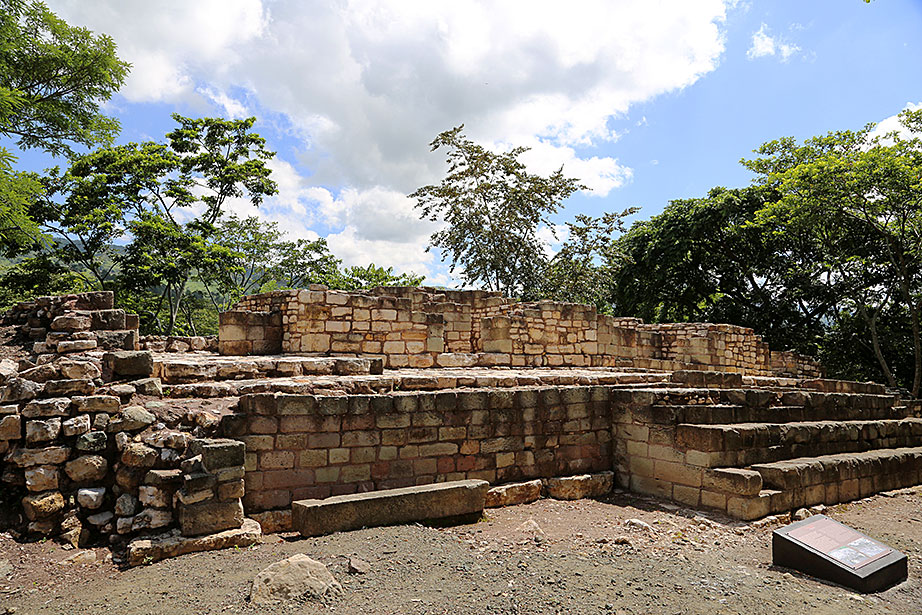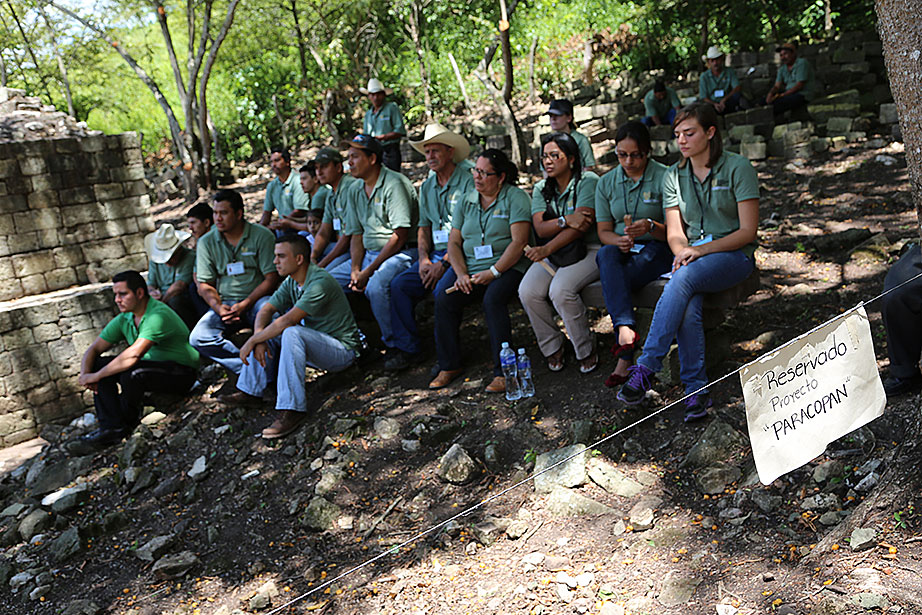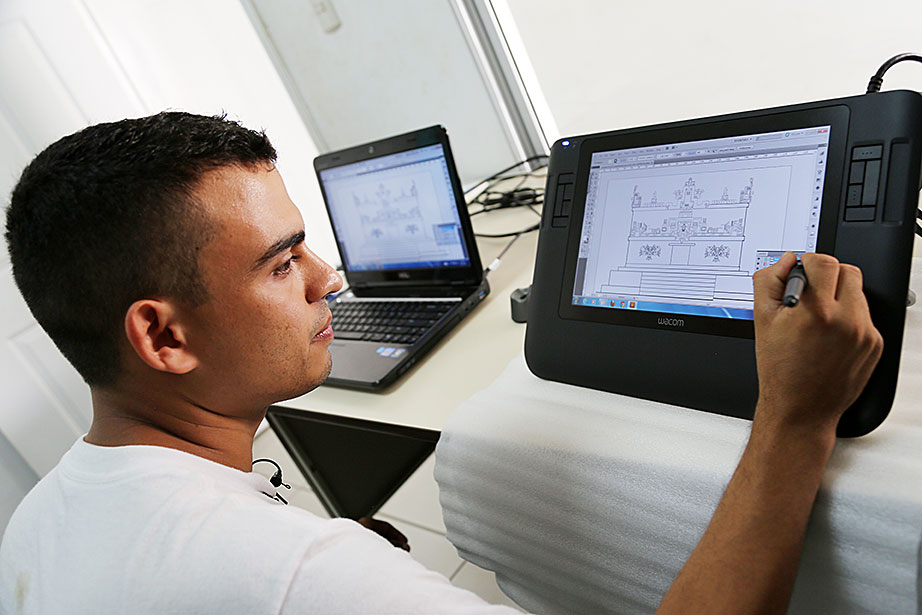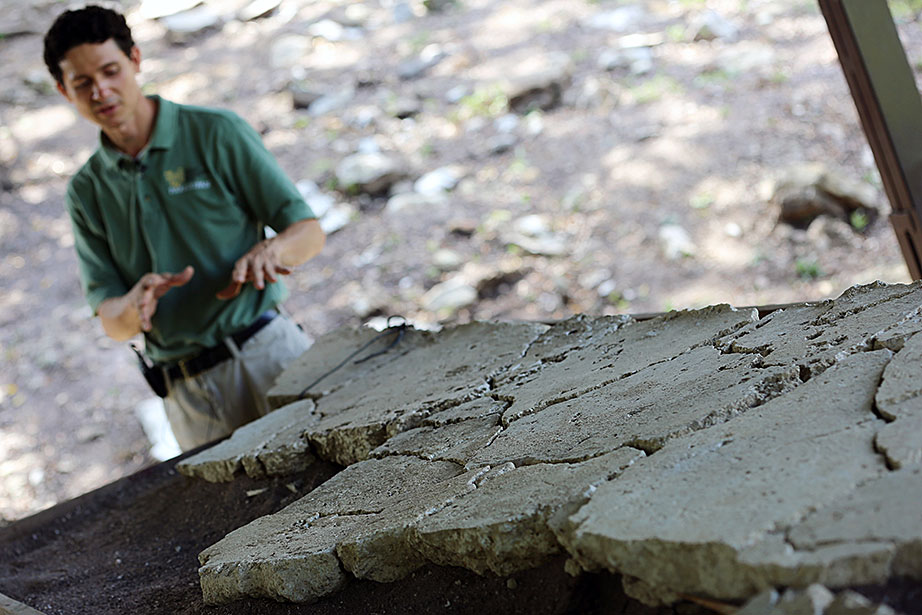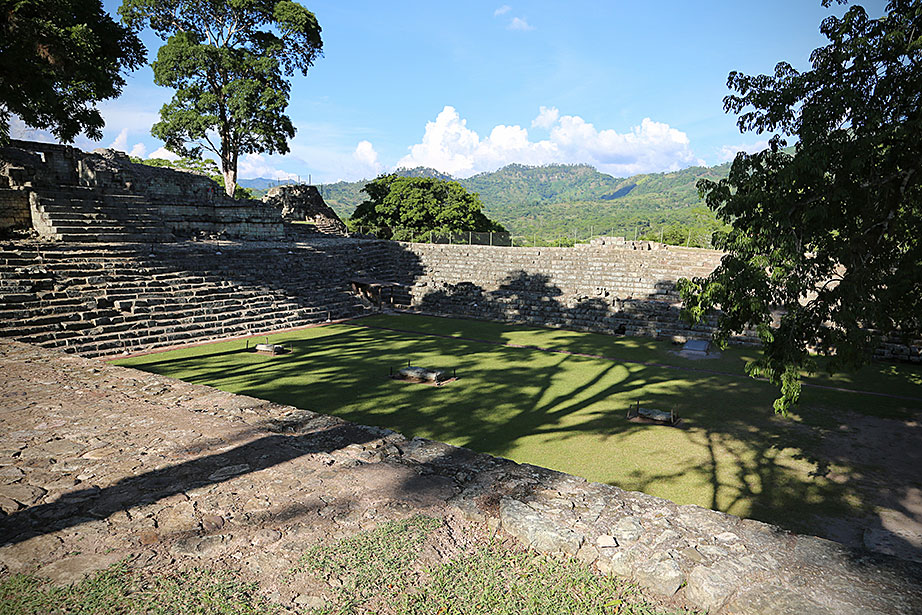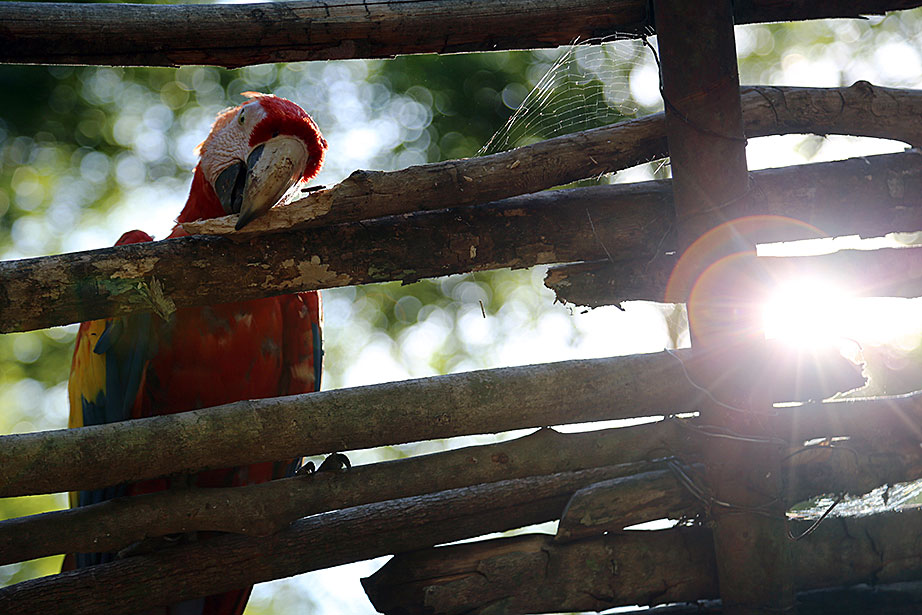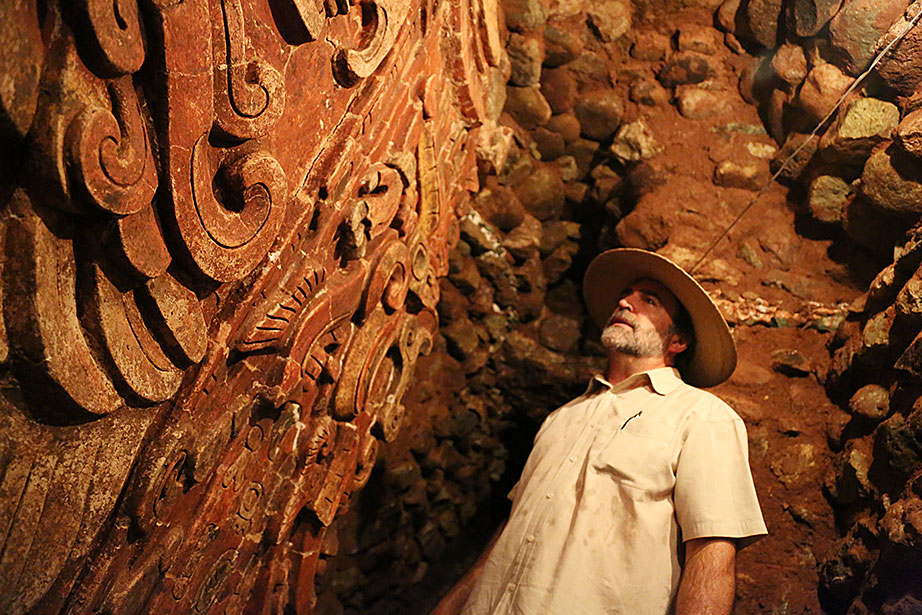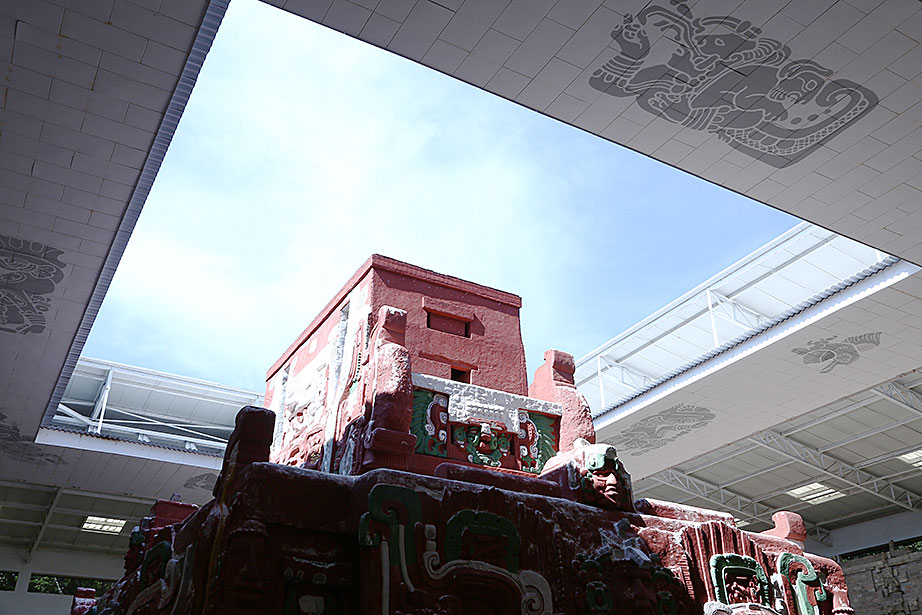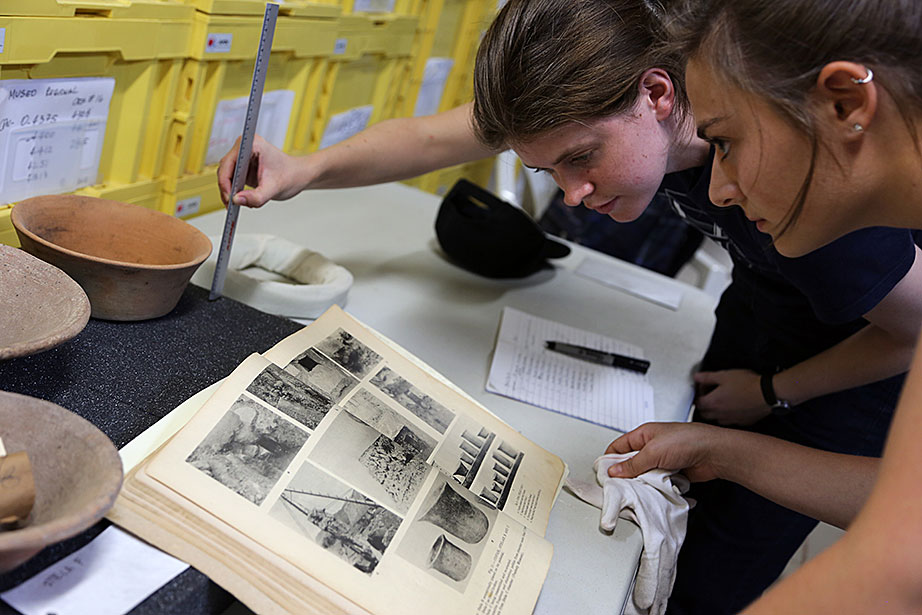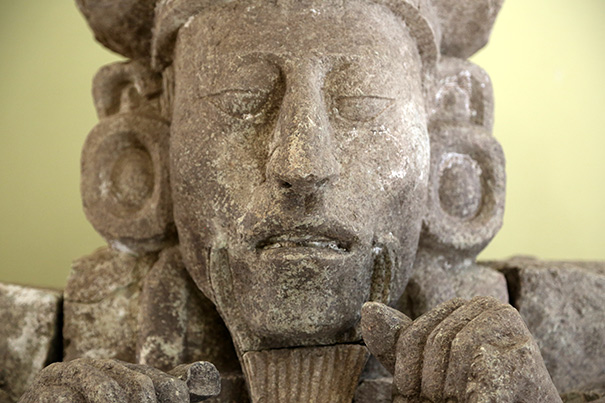
A sculpture of the head of the Maya ruler 12, K’ahk’ Uit’ Ha’ K’awiil, recovered at Rastrojón in the Copán Valley, Honduras. Researchers believe the site was a residential palace and military outpost.
Ned Brown/Harvard Staff Photogapher
Unraveling Maya mysteries
Harvard couple teams with Hondurans to excavate, safeguard ancient ruins
This is the sixth in a series of stories about Harvard’s engagement in Latin America.
COPÁN, Honduras — “We have to get you there for the ‘magic hour,’ ” said Bill Fash, peering through the spidery crack on the windshield of his old Ford pickup as he drove two visitors to the main Maya ruins in Copán.
The enchanted time of day at the majestic UNESCO World Heritage site comes at dusk, when the sun stretches its fingers across the massive Maya monuments and the lush valley floor. Encircled by mountains, the ruins contain an ancient world of buried secrets that members of the Harvard community and residents of Copán have been uncovering for decades.
As the long shadows receded into dusk, these primeval secrets seemed to hide once more. But the diligent industry of Fash, his wife and colleague Barbara, Harvard students, and a growing cohort of co-workers has ensured that unraveling the site’s riddles will continue.
Since 1970, Bill and Barbara have been toiling in Copán to restore, preserve, and protect the Maya culture and history for future generations. Their labors include a massive rescue operation for the site’s acropolis; creating a museum to house some of the site’s most precious sculptures, thereby protecting them from looters and weather; and safeguarding the Hieroglyphic Stairway, the longest hieroglyph (featuring stylized symbolic writing) in the Americas.
For the past seven years, the Fashes and their team have focused on their latest finding, Rastrojón, a rocky outcrop at the edge of the valley, away from the main ruins. Their efforts have slowly revealed the intricate imagery on countless sculptures that have brought to light the site’s ancient name, “Precious Puma Hill.”
Exposing a buried treasure
In the spring of 2007, Bill Fash, the Charles P. Bowditch Professor of Central American and Mexican Archaeology and Ethnology in Harvard’s Department of Anthropology, walked visitors through the as-yet-undisturbed space, speculating about what might lie beneath several large, earth-covered mounds. Last month, he gazed out at a massive stretch of tumbled rock at the same site, now covered by a long, yellow-and-gray tarp. The exposed building stones represent endless hours of excavation to unearth Structure 10, which Fash and his colleagues believe was a palace that likely housed nobility and the elite warriors who protected them. Built above three underground faults, the building, said Fash, “collapsed in spectacular fashion” in antiquity.
Behind him loomed a recreated wall of the structure’s façade, on which was pictured the head of ruler 12. He is also known as K’ahk’ Uti’ Witz’ K’awil, or Fire at the Edge of the Lightning God’s Waterfall, shown emerging from the mouth of a giant puma. The revered and powerful Maya ancestor was the longest-lived ruler in the city’s history, leading the kingdom in Copán from 628 to 695 A.D. Much of the site’s iconography makes direct reference to this fearsome warrior.
And while the Maya are known for a host of ancient rituals, on this same August day, a more familiar ritual was taking place. The Fashes stood at a temporary dais along with several distinguished visitors, including the Honduran vice president and the U.S. ambassador to the country. They were on hand to celebrate the site’s official opening to the public. They commemorated the opening and highlighted the ongoing collaboration between the local community and Harvard to protect and preserve Maya culture and history.
And that’s where another group of honored guests came in. A number of men and women had gathered quietly halfway up the hill, sitting on the dry ground. They wore jeans and olive shirts that read Proyecto Arqueológico Rastrojón Copan (PARACOPÁN). Some had straw cowboy hats to shield themselves from the sun. Receiving a summons from the group below, they scrambled to their feet and quickly formed a line in front of the vice president, who presented them with certificates acknowledging their work with the project and their expertise in a variety of specialized tasks.
That part of the ceremony was a surprise, organized in secret by the Fashes. Many of the workers stared at their “diplomas” sheathed in manila folders, smiling almost as if in disbelief. They had performed some of the most important work in the area in recent years, the result of PARACOPÁN, a program that inspires and trains the locals to become the guardians of their own heritage.
Training the local community
In his Cambridge office in the Peabody Museum of Archaeology and Ethnology a few weeks before the ceremony, Bill Fash talked about the importance of the local training program. While community members have always been involved in the projects, he and Barbara, who is director of Corpus of Maya Hieroglyphic Inscriptions at the Peabody, slowly realized that the lack of a stable research program functioning at all times in Copán meant that many of “the best people that we had trained in years gone by had migrated into other kinds of work.”
That brain drain became a top concern for the Harvard researchers, whose active engagement in Copán is likely to decrease eventually. So with several Honduran partners, they developed a program of training, conservation, rescue archaeology, and community engagement.
Rastrojón seemed the perfect test site for a better program. There the Fashes have trained 30 local young people and dozens of undergraduates and graduate students working with the Harvard Field School in Maya archaeology, teaching them archaeological and conservation methods and theories.
One of the Fashes’ earliest trainees was Jorge Ramos, now co-director of the site at Rastrojón. His voice hoarse from the many interviews he’d conducted with Honduran radio and TV outlets throughout the day, Ramos, who was born and still lives in Copán, explained the importance of the site’s sculptures to a persistent questioner. By then, the crowd had retreated up the hill to sip wine and munch on chicken tamales in the shade of a white tent.
The site’s images — a serpent, butterflies, and the impressive face of the open-jawed puma — all relate to the culture of war, explained Ramos, a slender man whose crop of curly black hair had begun to stick to his head from the heat. He pointed to the carvings of the snake and flittering insects on the palace’s recreated wall. Turning to the valley, Ramos pointed out a series of stelae, tall, stone monuments lined in a row, barely visible in the distance at the entrance to the valley, where warriors on guard likely lit fires as part of a warning system to alert Rastrojón to advancing friends or foes.
A cloud of butterflies began to swirl. Buffeted by the breeze, they created a mild frenzy of soft yellow, white, and occasional black markings, with a flash of an aqua-blue wing. Their appearance was Ramos’ cue to explain that in Maya lore, the insects symbolized death. “When a warrior died [in battle], he would become a butterfly,” and feed on flowers and nectar for all eternity.
This skilled archaeologist, who with the support of the Fashes and other colleagues obtained his Ph.D. in archaeology from the University of California, Riverside, in 2006, almost took a very different path in life. He first showed up in Copán in 1989, hoping to help manage the accounting books for a project at the main ruins (he had studied finance in high school). But he learned the job had been filled. Disappointed, he bumped into Bill Fash on his way out. Fash told him there were many parts of the project he could work on if he was willing to learn.
“He put me on the path,” said Ramos with a smile.
Safeguarding a cultural heritage
At the site the following day, a smiling Harvard graduate watched as visitors began to filter through the ruins on their first official day open to the public.
During her College days, Kate Brunson ’08 worked closely with Barbara Fash, helping to preserve plaster casts of Maya and Aztec monuments made in the field in the late 1800s and early 1900s, and housed at the Peabody Museum. Before heading to graduate school in archaeology, Brunson worked at the Harvard Field School in Copán, helping to draw detailed maps of the stone sculptures of Rastrojón’s Structure 10. Grateful to Harvard and the Fashes, Brunson also said collaborating with local Maya experts had been a gift.
“It’s really fun to be able to see how they are now really the experts in archaeology here at Copán,” she said
Nearby was one of those experts, Jose Carlos Gonzalez, 25, wearing a T-shirt bearing an image of the Rosalila Temple, the sixth-century Copán masterpiece, a replica of which dominates the Copán Sculpture Museum.
Gonzalez described how he started at the site in 2010, helping Barbara Fash to paint the replica temple in its bold shades of red, white, green, and yellow. A talented artist, he was later trained to capture images of the ruins on paper, and ultimately began carefully fitting pieces of Maya sculpture back together.
“I really love that … it’s like a big, big puzzle. The difference with a puzzle is that you have a picture that you are following. You have a guide. Here we have nothing.”
Gonzalez said that while he was always interested in the ruins, he thought at first the local population didn’t appreciate the conservation efforts. But his own involvement and that of others has altered his view.
“I am part of something the world is going to see,” he said, “and it’s wonderful.”
Later in the day, at the nearby conservation lab, Gonzalez gently brushed sand and dust from a slowly emerging façade of Structure 10 that was being pieced together, first in a giant outdoor sandbox, and later on the ground floor of the sculpture museum. The meticulous process involves mixing and matching pieces, to pair the perfect curve of one with the exact indent of another.
“I always joke that archaeologists are frustrated kids that did get enough time in the sandbox,” said Bill Fash, noting that arranging works there gives researchers the chance to rearrange pieces to make sure they have the best fit before adding mortar to hold them together.
Touring the lab’s vaulted sculpture storage area, the Fashes discussed some of the thousands of relics that they and their team have unearthed, cataloged, and preserved. “Let’s just see what our latest number here is,” said Bill Fash, grabbing for a Tyvek label on a rounded piece of light-brown sculpture that once served as an incense burner. “Thirty-two thousand fragments of sculpture, and there’s still quite a ways to go.”
In his own room sat the pieced-together head of Ruler 12. “A beard showed reverence to people in advance years,” said Barbara, an expert on Maya sculpture, explaining the pointed section of stone carved to look like hair on the sculpture’s chin. “They are showing that he was able to live to a ripe old age. But at the same time, his features are those of a young person. It’s a funny, idealized portrait — our great and long-lived ruler — with no wrinkles.”
Tunneling into the past
If Rastrojón sits at one of the highest points in the Copán kingdom, the tomb of its founder sits at its lowest. The Maya carefully constructed their buildings atop one another. As such, a multilayered, soaring pyramid in the main ruins represents many generations of Maya rulers and the temples built in their honor. And there’s nothing archaeologists like more than doing a little digging into the past to get to where a civilization began.
A series of tunnels dug deep into the base of the acropolis has helped researchers to travel back in time to the days of the founder, K’inich Yax K’uk’ Mo’. On this day, Bill Fash was keen to show Brunson and one of his new Ph.D. students, Alexis Hartford, part of this underground labyrinth and the riches buried within.
The trek through the tunnels is instantly disorienting. In a few short steps, the familiar screeching of macaws outside is silenced. Voices are muted and muffled by the narrowing space. Light is overcome by blackness.
“This is kind of fun here because they are keeping the lighting to a minimum,” said Fash, as he led a small group further into the darkness. “I am real glad I know where I am going because there is a deep hole at the end of this tunnel. Whatever you do, don’t go straight here. Take a hard left at this point, or you won’t live to tell the story,” he instructed his followers, who responded with nervous laughter.
Suddenly the space opened slightly to reveal a massive stone carving, a plaster relief in red and green bearing the name of K’inich Yax K’uk’ Mo’. The imagery is carved into the side of a temple — nicknamed “Margarita” by the archaeologists – that was built by the founder’s son and successor around the year 450 and is located directly atop the founder’s own funerary temple.
Further on, Fash, his face glistening with sweat, his linen shirt soaked through, curled himself into a ball at the end of a tunnel. Sitting in the red dirt, he directed Hartford to crawl on her hands and knees down an adjacent 10-foot stretch and drop into a hollowed-out space so she could peer into the tomb of the founder.
Hartford was game and used the flash on her camera to illuminate the space.
“So this is ground zero,” said Fash. “The seat of power, literally of the dynasty.”
Later, back in the light of day, Hartford remarked on the tunnel trek. “It’s just amazing to see it in person,” she said. “Maybe I’ll find something like that someday. It gives me hope.”

